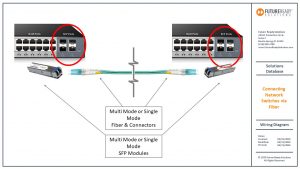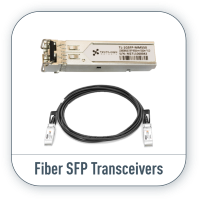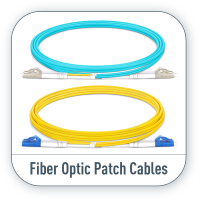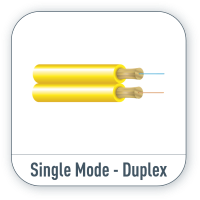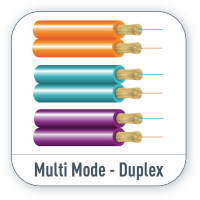Connecting Network Switches via Fiber
As network speeds continue to advance from 1 Gb and beyond, connecting network switches via copper limits data speed and the ability to upgrade in the future. Other than entry level network switches, most of today’s network switches include one or more GiBC (Gigabit Converter) or SFP (Small Form-factor Pluggable) slots. SFP modules insert into these slots and and require two strands of fiber, typically duplex Using multi mode fiber (for runs under 1000 feet) or duplex single mode fiber (for runs over 1000 feet). This is a cost-effective and high performance way to connect network switches.
Advantages
-
Fiber is immune from RF interference electrical interference and static electricty, power surges and lightning strikes
-
Fiber is not limited to the 1000 feet (330 meter) limit that copper is limited to
-
Fiber allows true duplex bidirectional transmitting and receiving of data signals and 1Gb, 10Gb speeds and beyond
Design Notes:
-
Determine the length of the fiber run and choose either multi mode for runs under 1000 feet or single mode for runs over 1000 feet.
-
SFP transceiver modules are specific to the type of fiber being connected (either single mode or multimode). Choose an SFP module based on the fiber optic cabling that will be connected to the network switches.
-
SFP transceiver modules almost always require two fiber optic cable strands. Always integrate duplex (two strand) fiber optic cabling or higher strand counts.
-
Most modern SFP transceiver modules feature duplex LC connections. Terminate your fiber optic cabling with two LC-style connectors or purchase a pre-terminated fiber optic cable with two LC-style connectors.
-
When connecting terminated duplex fiber optic cable between two network switches, ensure the connections are reversed between the SFP transceiver ports (connection A to B and B to A). SFP transceiver modules rely on the transmission of separate send and receive signals.
-
Select an SFP module that matches the bandwidth of your network switch. 1G modules are technically classified as SFP transceivers, 10G modules are classified as SFP+ transceivers, and QSFP transceivers support even higher bandwidths.

